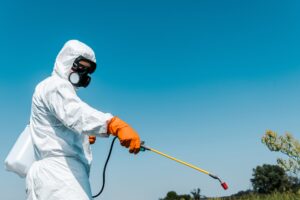As the days grow shorter and temperatures start to dip, a wide array of pests view human structures as inviting havens. Here are a few compelling reasons to spray for pests in the fall, plus some ways you can safeguard your buildings from unwanted visitors.
Common fall pests
Many pests try to migrate into buildings before winter sets in, and some are brought in as unexpected, unwelcome guests. Here are some common visitors that can be controlled when you spray or seal potential holes around your home or business:
- Cluster flies. These are parasitoids of earthworms as larvae and the adults congregate in large numbers in the fall, seeking refuge in the largest buildings they can find to overwinter. Cluster flies are a nuisance, often considered sluggish fliers, are not from decaying organic matter unlike many other flies found indoors, and can be often be found clustered around lights and sunny windows on warmer winter days.
- Carpenter ants. Carpenter ants are active year-round if their nest locations are warm enough. If they are found indoors in the winter, the structure most likely had some water damage that attracted them inside during the warmer months. Spray the exterior to keep the majority out. They can cause significant damage to wooden structures.
- Bed bugs. While bed bugs are a year-round problem, they can be more noticeable in the fall because of holidays, travel, people spending more time together, and increased indoor activities. They tend to hide in cracks and crevices of walls, furniture, and items near where people spend time sitting or relaxing.
- Cockroaches. While cockroaches are also a year-round problem, they can be introduced from food and infested items brought indoors. They tend to hide in cracks and crevices near food, water, dark areas, and warmth.
- Crickets. These nocturnal, omnivorous insects often find their way indoors when temperatures drop. Their chirping can be a nuisance, and they may damage fabrics and paper products.
- Box elder bugs. These plant bugs are known for feeding on boxelder, maple, and ash trees. In the fall, they congregate on the sunny sides of tall buildings in large numbers. They can enter structures through cracks and openings.
- Asian lady beetles. These invasive ladybugs seek shelter indoors when fall arrives. While they’re beneficial in gardens, they can be a nuisance indoors.
- Weevils. Weevils, such as vine weevils, may be found entering structures in the fall. Others, such as rice and granary weevils may infest stored food products in your pantry.
- Mice and rats. Rodents are notorious for seeking warmth and food inside buildings during the colder months. Mice and rats can contaminate food, spread diseases, and chew on wires and cause fires.
Preventing fall infestations
Several things to prevent pests from entering buildings in the fall include:
- Sealing cracks and openings. Inspect your building for cracks, gaps, and openings where pests can enter. Seal them with caulk, weatherstripping, or mesh screens. Ensure that window and door screens are intact and fit snugly. Enlist the help of Poulin’s Pest Control to identify and address the root causes of infestations.
- Perimeter pesticides. If you have insect pests that enter every fall such as lady beetles, cluster flies, boxelder bugs, crickets, or other insect invaders, apply pesticides around the perimeter of your home or business in early fall to create a barrier that deters pests.
- Maintain cleanliness. Keep your building clean and free of food crumbs, spills, and clutter. This removes potential attractants and nutrition for pests.
- Proper storage. Store food in tough, sealed containers to prevent pantry pests like beetles, weevils, ants, and moths from infesting your supplies.
Fall pest control in Western Canada
Don’t let uninvited guests ruin your autumn. Turn to Poulin’s Pest Control to protect your buildings from seasonal invaders. Contact us today to learn more about our commercial and residential pest control services.

